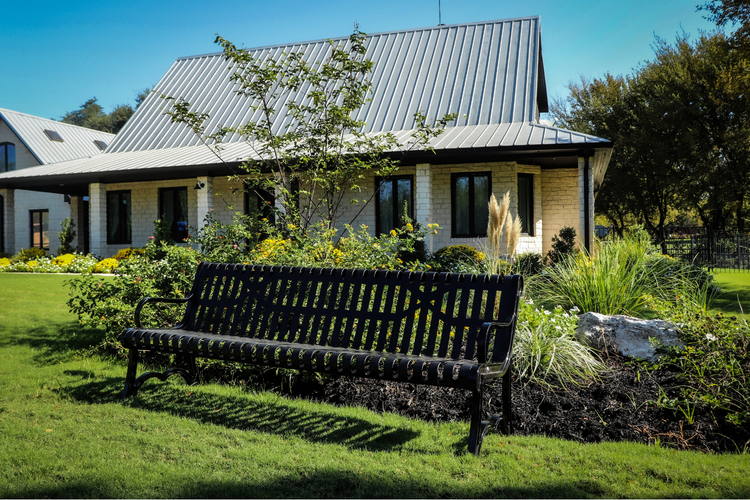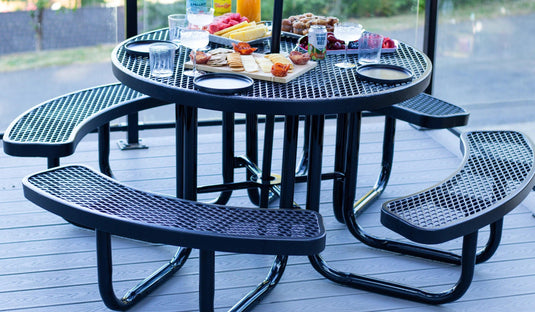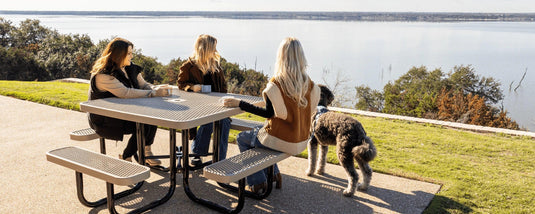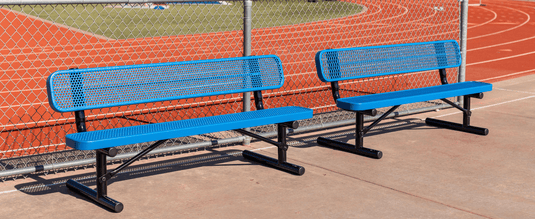If you’re shopping for commercial-grade outdoor furniture, you’ve probably come across two common finish types: polyethylene coated steel and plastisol coated steel. At a glance, they might seem similar—they both involve coating steel furniture with a thick, protective layer. But when it comes to performance, durability, and maintenance, there are some important differences.
Whether you're outfitting a park, schoolyard, playground, or outdoor dining space, here's what you need to know about the real-world pros and cons of each coating type.
1. What’s the Difference, Exactly?
Let’s start with the basics:
-
Polyethylene coating is a hard, dense, and UV-stabilized plastic layer applied to steel furniture. It’s heat-bonded for a smooth, uniform surface that’s durable and long-lasting.
-
Plastisol coating is made from PVC (polyvinyl chloride) and is applied as a liquid that’s heated until it forms a rubbery, textured finish over the steel frame.
Both are designed to protect steel from rust, moisture, and physical damage—but how they perform over time is where they start to differ.
2. Durability Over Time
Polyethylene coated furniture is known for its tough, resilient surface. It holds up well in extreme weather, resists cracking, and won’t peel or flake with age. It’s especially ideal in high-traffic or harsh environments like parks, schools, or coastal areas.
Plastisol coating starts off thick and soft, but over time it can become brittle, especially when exposed to long periods of sun or freezing temperatures. It’s more prone to cracking and chipping, especially in colder climates.
👉 Verdict: Polyethylene offers better long-term performance in all-weather environments.
3. Surface Feel & Appearance
Plastisol has a slightly rubbery, bumpy texture, which some people like—but it can also feel sticky in hot weather or slippery when wet. It tends to hold onto dirt, making it harder to clean.
Polyethylene coating has a smooth, dense finish that looks polished and feels comfortable year-round. It doesn’t get as sticky or slimy in the elements, and it wipes clean with just soap and water.
👉 Want furniture that looks fresh and feels good? Polyethylene wins here.
4. UV Resistance & Fading
One of the biggest complaints about plastisol-coated furniture is that it fades and breaks down under UV exposure. Over time, you might see discoloration, brittleness, or surface cracking.
Polyethylene is UV-stabilized, meaning it resists fading and stays vibrant, even in direct sunlight. It’s a better option for outdoor areas with lots of sun exposure, like schoolyards and splash pads.
👉 Color that lasts = less replacement, fewer complaints.
5. Maintenance & Cleanability
Plastisol is a little more porous and textured, which means it can trap dirt, food, gum, and graffiti more easily than smoother surfaces. Over time, it can look dingy—even if it’s structurally fine.
Polyethylene coated steel is much easier to keep clean. It’s non-porous, graffiti-resistant, and wipes down with minimal effort. It’s a big reason why it’s so popular for public-use furniture.
👉 Less cleaning time = more uptime and lower labor costs.
6. Cost & Value
Plastisol-coated products are often slightly cheaper up front, but the cost savings may not last. If you need to replace or repair the coating sooner—or deal with added cleaning and maintenance—it can cost more over time.
Polyethylene coated furniture tends to be a little more premium in price, but it's built for decades of use, not just a few seasons.
👉 Think long-term. Polyethylene gives you more value over the life of the furniture.
Final Thoughts
Plastisol-coated steel might work fine in some short-term or residential settings—but for high-traffic, commercial, or all-weather environments, polyethylene coated steel is the stronger, smarter choice.
It looks better longer, holds up to wear and tear, and keeps maintenance to a minimum—making it ideal for parks, campuses, HOAs, municipalities, and anywhere outdoor furniture needs to work hard and look good doing it.
Explore our full selection of heavy-duty, American-made polyethylene coated furniture here, or reach out if you want help choosing the best product for your needs.





